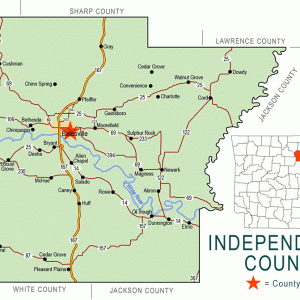calsfoundation@cals.org
Graham (Independence County)
The historic community of Graham was located in Washington Township near where Lock and Dam No. 3 on the White River is today. It is on the Lock 3/Webber Chapel Road near Pilgrim Holler, about two miles north-northwest of Bethesda (Independence County). The University of Arkansas Livestock and Forestry Station is located on land that was once part of Graham.
Moses Graham was a son-in-law of Abraham Ruddell, who helped establish Ruddell Mill, one of the first water-powered mills in the White River valley. Graham owned a farm at Bell Point on the White River opposite the mouth of Salado Creek. In 1815, he was appointed, along with the widow of John C. Luttig, as administrator of the Luttig estate. Luttig was the most successful merchant in Polk (a.k.a. Poke) Bayou, and his trading post was a popular stopping place for woodsmen and others traveling through the region. In 1816, Moses Graham had a ferry on White River at Bell Point.
Graham and his wife, Sarah, sold the farm and ferry and moved to Clark County, where he died in 1821; the couple had one child, Abraham Ruddell Graham. Sarah Graham took Abraham back to Independence County to the home of her parents. She later married Ambrose Creswell of the pioneering Creswell family of Izard County. Abraham Ruddell Graham married and had two sons; he was killed by a runaway slave while crossing the White River north of Batesville (Independence County) in January 1850.
The Graham post office was established in 1852 with a local farmer, William W. Glenn, appointed the first postmaster. The post office, which was part of a trading post, is believed to have been called Graham to honor Abraham Ruddell Graham’s memory. The community was strategically located close to the Hess/O’Neal/Grigsby Ferry on the White River, which was a main route of travel in the mid-1800s. Steamships traveled the upper White River beginning in 1831. Crossing the ferry was part of the alternate route for the military road to Mount Olive (Izard County) and Yellville (Marion County) and on to Kansas City, Missouri.
Census and tax records show that William W. Glenn, Graham’s first postmaster, arrived in Washington Township from North Carolina around 1828 and gradually added acreage to his farm until he owned a large portion of the land in Graham. He married Martha E. Hassell from Tennessee, and they had at least five children. Glenn continued to farm in Graham until his death, which was sometime after 1897. Glenn Creek near Lock and Dam No. 3 is named for him.
Another early settler of the region was Samuel Blair, who came from Roane County, Tennessee, with his new wife, Susan Elizabeth Porter Blair, in 1848 to farm the alluvial White River bottomland in Washington Township. Shortly after their arrival, the first of their nine children was born. In 1854, Samuel Blair became the second postmaster of Graham. He served in the Confederate army during the Civil War and participated in the Skirmish at Waugh’s Farm on February 19, 1864. He and his son, Robert Blair—who became a physician in Graham, eventually establishing a practice in Batesville in the 1890s—are both buried in the Blair Cemetery, which, along with New Hope Cemetery, served the Graham community.
Webber Chapel established a school for grades 1–8 in the early 1900s. The school, which was attended by the children of Graham, was still active in 1936 but was annexed by Bethesda in the 1940s.
The St. Louis, Iron Mountain and Southern Railway was completed from Batesville to Cotter (Baxter County), following the north bank of the White River, by the fall of 1903, and daily passenger service from Newport (Jackson County) to Batesville and on to Cotter was available, with the train going through O’Neal (Independence County). The tracks were extended to Carthage, Missouri, by 1906. O’Neal thus became a railroad whistle stop, with the tracks bypassing Graham.
The post office at Graham closed in 1909 and was replaced by the one in O’Neal. The population was shifting away from the historic communities of Washington Township to newer ones such as Bethesda and Cushman. Manganese and white-lime mining activities helped make Cushman and Bethesda prosper while Batesville, the county seat, continued to attract farmers for non-agricultural jobs.
The University of Arkansas Livestock and Forestry Station was created in 1937 and includes 3,042 total acres. Waugh Mountain near Webber Chapel is part of the station, which was opened to study and develop a system of farming adaptable to hills and lowlands of depleted fertility. Oran McBride’s stone quarry is located just south of the historic Graham community.
For additional information:
Adams, Walter M. The White River Railway, Being a History of the White River Division of the Missouri Pacific Railroad Company, 1901–1905. North Little Rock, AR: Walter M. Adams, 1991.
Huddleston, Duane. “Events from the Life of Moses Graham.” Independence County Chronicle 13 (October 1971): 24–35.
Huddleston, Duane, Sammie Cantrell Rose, and Pat Wood. Steamboats and Ferries on the White River: A Heritage Revisited. Fayetteville: University of Arkansas Press, 1998.
McAdams, Virginia. “The Battle of Waugh’s Farm.” Independence County Chronicle 2, no. 4 (1961): 3–6.
McGinnis, A. C. “A History of Independence County, Ark.” Special issue. Independence County Chronicle 17 (April 1976).
Strausberg, Stephen F. A Century of Research. Fayetteville: Arkansas Agricultural Experiment Station, University of Arkansas, 1989.
Kenneth Rorie
Van Buren, Arkansas
 Independence County Map
Independence County Map 




Comments
No comments on this entry yet.